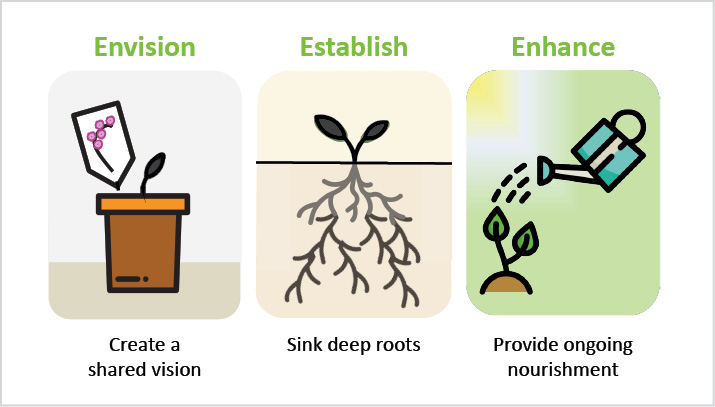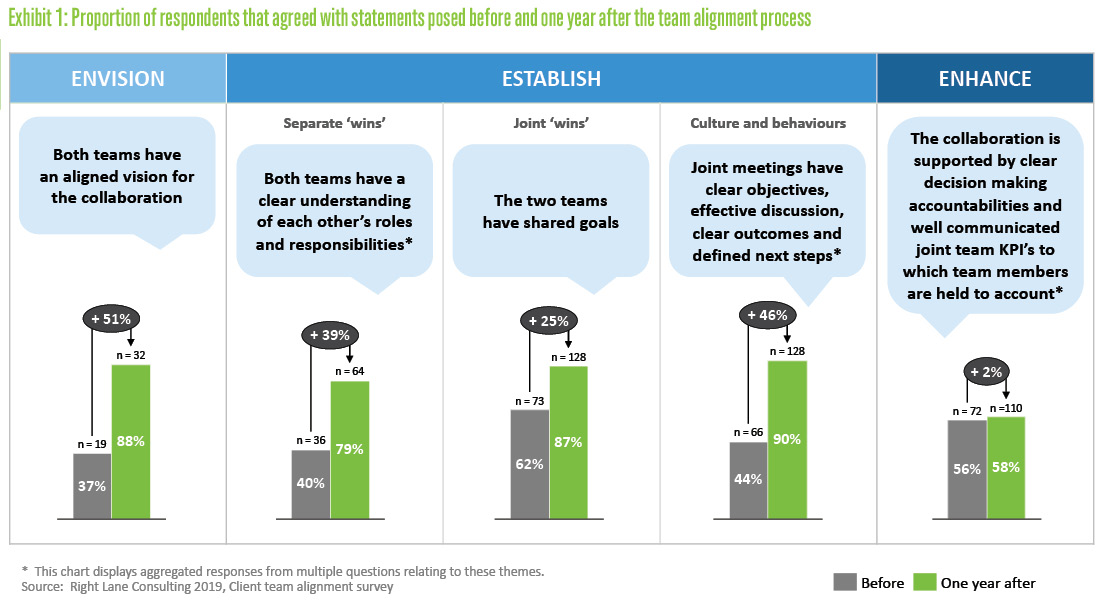Building a collaboration strategy: your key to unlocking collaborative advantage
by Zoe Pappas & Dr James Mills
Right Thinking
Effective collaboration is one of the most valuable sources of competitive advantage. Unfortunately, as insular team priorities can often work against the joint goals of an alliance, spontaneous collaboration is rare. A collaboration strategy is an effective tool for building alignment and enabling cooperation. At Right Lane we’ve seen this technique produce dramatic and enduring results both when employed within an organisation, to remove friction between different functional units, and externally, to forge lasting alliances with external partners.
Today’s business models are increasingly dependent on collaboration, both internally, between different business units and functional teams, and with external partners and stakeholders. In recent years, we have seen an increasing appetite for forging strategic alliances rather than maintaining purely transactional relationships. And for good reason: when healthy collaboration flourishes, strategic partnerships can unlock mutual value that far exceeds the benefits delivered through a simple outsourcing arrangement.
In this article we outline the three phases of Right Lane’s approach to building powerful collaborations and highlight the impact this approach has delivered for a client.
Collaborative advantage
Alliances are prolific in nature. A classic example of this is the symbiotic relationship between the sea anemone and the hermit crab. The crab actively recruits anemones which attach to its shell and ward off would be predators. In return, the anemone, ordinarily incapable of independent movement, is carried far across the ocean floor and feeds upon the crab’s leftovers.
Similarly, organisations with complementary capabilities can forge strong alliances that deliver mutual value for both parties. This is particularly effective when alliances enable allied partners to deliver an integrated service that any individual competitor would be unable to match, thus establishing a ‘collaborative advantage’ (Kanter 1994). A collaboration strategy is a powerful framework for formalising these alliances, ensuring they continue to deliver the mutual value they were created to unlock.
Collaborative advantage can not only be developed through external relationships. Most large organisations incorporate semi-autonomous functional teams with common stakeholder groups. By formalising the alliance between these teams, organisations can unlock a valuable internal source of collaborative advantage.
Collaboration must be cultivated
When collaboration does not flourish organically, leaders must actively cultivate it. Our approach to building alignment between partners involves three steps. First, we assist teams to articulate a shared vision for the collaboration. Next, we establish a strategic framework to support the collaboration, clearly specifying the individual and joint objectives and the processes, values and behaviours required to achieve them. Finally, we work with our clients to agree mechanisms for monitoring, reviewing and enhancing the collaboration.
Approach to building alignment between partners
Envision
Imagine being given a seedling along with instructions for its care but having no conception of how the plant will look when in bloom. It is likely that you would feel little motivation to care for your new companion. For this reason, seedlings are usually sold with a photo of the mature plant.
Similarly, creating a shared vision for the collaboration is an important first step in developing alignment between teams. This joint aspiration serves as a pervasive reminder of what the collaboration is working to achieve. It is the focal point around which teams can build their collaboration strategy.
Establish
Collaboration exists to unlock sources of value that neither party could realise independently. Understanding these sources of value is essential for the collaboration to sink the deep roots required to reach them. There are various ways of framing this discussion. One approach we often take draws upon the work of Robert Kaplan, David Norton and Bjarne Rugelsjoen (2010).
The first step in this approach is to understand what each party stands to gain individually from the collaboration. In our client work we’ve seen that a lack of common understanding of each parties’ individual wins can be a major source of friction. For example, one alliance we recently worked with had deteriorated because, for one party, it was failing to deliver enough scale in new business to produce a net economic gain. We were able to get this alliance back on track by providing clarity around what each party needed from the collaboration and agreeing a way forward that delivers mutual value for both parties.
Once the benefits for each party are well understood we move on to consider the common goals of the collaboration. These are the customer or end-user focussed outcomes the collaboration is working to achieve. We then ask, ‘What joint initiatives and internal processes do we need to deliver these outcomes?’ and, ‘What values and behaviours are required for the collaboration to function effectively?’. We assist our clients to ‘bottom out’ these discussions and capture their outcomes in a collaboration strategy, or ‘compact’.
Enhance
Effective collaboration requires two forms of ongoing nourishment, a formal monitoring and review process and an ongoing commitment to building a shared culture. Like water and sunlight, both are required for the collaboration to thrive.
In addition to monitoring end-user outcomes, formal measurement, monitoring and review systems should be established to track adherence to the processes, values and behaviours articulated in the collaboration strategy. The key to making this work is establishing clear expectations and explicit accountability.
The second form of nourishment involves building a shared culture across the collaboration. There are several mechanisms for building team unity. In our experience, the most successful approaches regularly bring teams together in both social and professional contexts: for example through regular joint team meetings, social gatherings and staff secondments.
Building collaboration in practice
We’ve seen this approach deliver dramatic changes, both when used internally to foster alignment across teams, and externally, to forge strong alliances that deliver mutual value. We recently ran a team alignment check-up after running a collaboration process for a dysfunctional internal collaboration. An anonymous poll delivered one year later revealed that 92% of staff believed collaboration between the two teams had improved. Of these, 91% agreed that this improvement had resulted in greater end-user outcomes.
The process of developing a collaboration strategy is in itself a powerful tool for building team alignment. However, as staff members move in and out of the teams the alignment built during any one-off process is likely to erode. Building a collaboration strategy provides a framework for onboarding new team members so that every new colleague strengthens the collaboration. The check-up we recently administered for one client revealed that, one year on, collaboration had dramatically improved despite the joint team having almost doubled in size (See Exhibit 1).
It is all too easy to accept friction between teams to be the natural state, unavoidable, or simply too hard to address. However, in our experience, by putting the spotlight on collaboration, teams can dramatically reduce friction and by doing so unlock their collaborative advantage.
References
Kanter, R 1994, ‘Collaborative advantage: the art of alliances’, Harvard Business Review, July
Kaplan, R, Norton, D & Rugelsjoen, B 2010, ‘Managing alliances with the Balanced Scorecard’, Harvard Business Review, Jan-Feb
© 2019 Right Lane Consulting
We hope the ideas presented here have given you something new to think about. We would love the opportunity to discuss them with you in more detail. Get in touch today.



